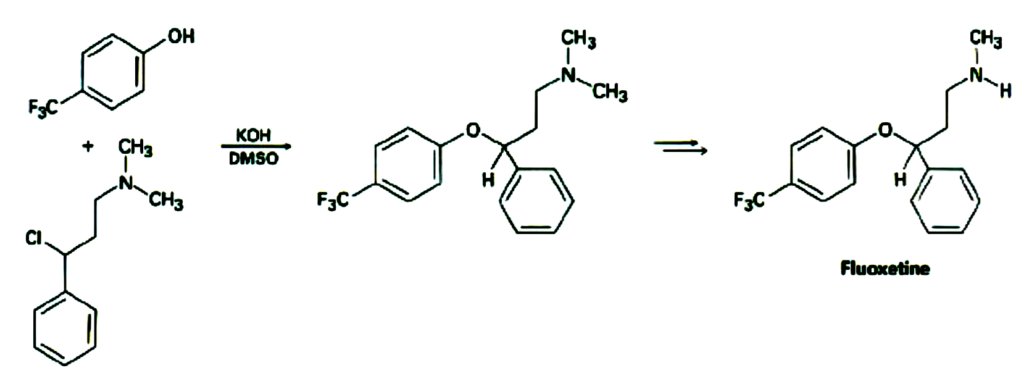Interesting facts from the world of organic chemistry
Derivatives - halogen compounds:
Fluoxetine
Fluoxetine is the trivial name of the active substance of a drug intensively prescribed in the treatment of depression – an antidepressant. This drug belongs to the group of SSRIs, or selective serotonin reuptake inhibitors. These substances prevent the reuptake of the serotonin mediator from the nerve synaptic cleft. The substance fluoxetine is known under the original trade name Prozac (USA). In the Czech Republic, we can meet names such as: Magrilan, Apofluoxetine, Fluzak, Deprex, Fluoxetin Ratiopharm or Defluox.
The daily dose is usually around 20 mg. It is usually taken once every day. Splitting this dose into up to three smaller rations is also common. The desired therapeutic effect is manifested with a delay of two to three weeks, because the metabolite of fluoxetine formed in the liver is active. This fluoxetine metabolite is called norfluoxetine.
The active substance of the preparation can be synthesized, for example, by a reaction between the relevant phenol and chloroalkyl. This is shown in the figure below.

Picture above: Scheme of synthesis of Fluoxetine.
How does it work?
Fluoxetine works by increasing serotonin levels in the brain. Serotonin is a neurotransmitter that plays a role in regulating mood, behavior and other functions.
Effects
Fluoxetine may improve the following symptoms:
· Depressed mood
· Loss of interest or pleasure
· Loss of energy
· Difficulty concentrating
· Trouble sleeping
· Difficulty eating
· Suicidal thoughts
· Obsessive-compulsive thoughts or behaviors
· Bulimia
· Hot flushes and irritability before menstruation
Dosage
Fluoxetine is usually taken once a day in the morning or evening. The recommended starting dose is 20 mg per day. Depending on effectiveness and tolerance, the dose can be increased up to 80 mg per day.
Effects usually appear within 2-4 weeks, but it can take up to 6 weeks for the effects to be fully felt.
Safety
Fluoxetine is generally considered a safe drug. Common side effects include:
· Nausea
· Vomiting
· Loss of appetite
· Increased appetite
· Increased anxiety
· Feeling sleepy
· Sleep Disorders
· Nausea
· Vomiting
· Headache
· Dry mouth
· Constipation
· Perspiration
· Feeling restless or irritable
· Changes in sexual behavior or function
· Decreased libido
· Difficulty reaching orgasm
· Menstrual irregularities
Rarely, serious side effects such as:
· Suicidal thoughts or behavior
· Serotonin syndrome (severe symptoms such as fever, tremors, rapid heart rate, sweating, confusion, and coma)
· Allergic reactions
· Preparation for taking fluoxetine
Before starting fluoxetine, it is important to tell your doctor about all of your medical conditions, including allergies, other medications you are taking, and pregnancy or breastfeeding.
While taking fluoxetine
It is important to see your doctor regularly while taking fluoxetine to monitor its effectiveness and address any side effects.
Discontinuation of fluoxetine
Fluoxetine should be discontinued gradually to avoid withdrawal symptoms such as nausea, vomiting, dizziness, and confusion.
Conclusion
Fluoxetine is an effective medication that can help improve symptoms of depression, OCD, bulimia nervosa, and PMDD. It is important to remember that fluoxetine can also have side effects, so it is important to use it only on the recommendation of a doctor.
Sources:
[1] J. McMurry, „Fluoxetin,“ v Organic Chemistry, Seventh Edition, Belmont, Thomson Learning, 2008, p. 682.
[2] Ratiopharm GmbH, „TEVA,“ 14 12 2011. [Online]. Available: http://teva.cz/pdf/FLUOXETIN-RATIOPHARM20MG_spc.pdf. [Přístup získán 7 6 2013].
